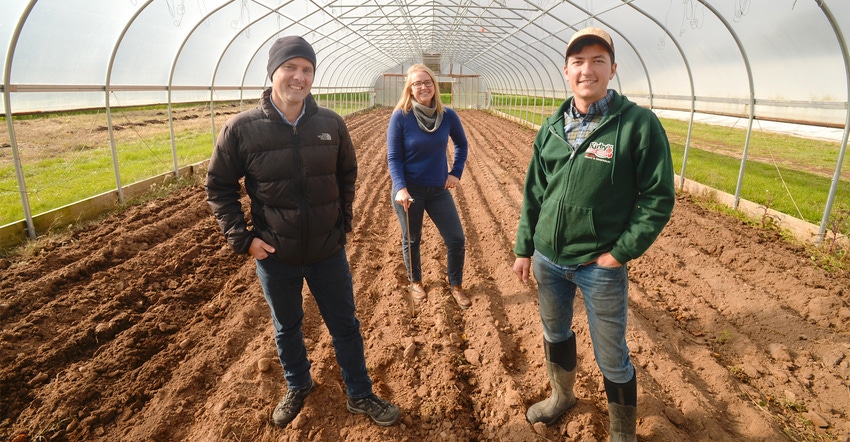January 26, 2018

Foliar testing has become a farm-wide practice for Kirby’s Farm Market of Brockport, N.Y. — not just in their high tunnels, and for good reason: It’s an early clue of soil health needs for higher vegetable yields.
“Learning about soil health to enhance our high-tunnel tomato production impacted the entire farm,” says Chad Kirby, who operates the fifth-generation business with his parents Tim and Linda along with sister Stacey. The farm grows more than 25 different fruit and vegetable crops. Fresh-picked produce feeds 180 Community Supported Agriculture members. The mix also includes flowers and Christmas trees.
“We now use foliar testing to manage high tunnel tomatoes and field-grown tomatoes, peppers, cucumbers, and zucchini,” Kirby adds. Working alongside Cornell Extension Vegetable Specialist Judson Reid and Research Technician Cordelia Machanoff, he learned to collect and submit foliar samples to a lab for testing. Now, he also knows how to interpret reports of foliar-level macro and micronutrients crucial for healthy crops.
Targeting invisible plant needs
Testing in 2016 indicated serious deficiencies in nitrogen and potassium. “We adjusted inputs, and levels in 2017 were in ideal ranges for the entire growing season,” he says.
The key was applying target nutrient fertilizers. In this case, providing a 1:3 nitrogen-to-potassium ratio that replaced all-purpose fertilizer. He stopped adding additional phosphorus and calcium.
“Having someone who knows how to properly collect samples on the farm was a great introduction to soil health,” Kirby says. “The opportunity to increase my knowledge by working with Jud expanded our high-tunnel production for 2018.
“Foliar testing is critical to detect fertility imbalances before visual symptoms become apparent. Sampling two weeks post-transplant and then every 2 to 3 weeks through the season has the potential to increase income by boosting yield while decreasing inputs,” Reid says.
Grasping grafting
The Kirbys have grown tomatoes in a high tunnel for three years. Working with Reid, they added foliar testing and grafting to their standard practices. From 2016 to 2017, they saw a 2,300-pound yield gain and an 18% increase in income.
The 2016 crop was an indeterminate variety pruned to harvest 10 to 20 pounds a week into fall. In 2017, shorter, bush-type tomatoes were selected to yield more fruit planted in a higher concentration.
“From 20% of the crop in 2015, we gradually increased our grafting to 100% in 2017,” Kirby says. “We saw significant differences in plant vigor, contributing to yield gain.
“Since starting this project in 2015, we’ve had virtually disease-free, healthy plants, with only one isolated incident each year. That’s excellent for the tunnel’s enclosed, high-humidity environment.”
Reid’s grafting work with tomato growers statewide has shown the potential for a gross revenue increase of more than $60,000 an acre.
 LESSONS LEARNED: Chad Kirby says learning about soil health has benefitted his family’s whole farming operation.
LESSONS LEARNED: Chad Kirby says learning about soil health has benefitted his family’s whole farming operation.

Other strategies employed
Here are other outcomes of the Kirby’s soil health education:
• Water quality was evaluated. Rising high-tunnel soil pH prompted adding sulfuric acid to tunnel drip irrigation.
• Crop rotations were reconsidered. “In 2018, we’re rotating tomatoes out to grow pickling cucumbers in the tunnel,” Kirby says.
• Tomatoes will move to greenhouse 11, where a gravel base for bedding plants has been removed.
“Number 11 has a furnace used to protect our spring flowers. That may help us start tomatoes earlier and harvest later,” he says.
• For 2018, this Monroe County farmer plans to add winter season cover crops.
High tunnel growers participating in Reid’s on-farm soil nutrient management projects have seen an average net income increase of $5,000 per tunnel. That accounts for much of the tremendous growth in high tunnels in the state, according to New York Farm Viability Institute director David Grusenmeyer.
NYFVI has partnered with the Northeast Organic Farmers Association — New York and Cornell Cooperative Extension to extend high-tunnel soil fertility education to help growers adopt and enhance their tunnel production and profitability. For more information on the program, contact Reid at 315-536-5123 or email [email protected].
NYFVI is a farmer-led nonprofit that invests in innovative projects to increase the success of ag production enterprises, protect farm-based natural resources and produce measurable farm-level results. Visit nyfvi.org for more information.
4 best high-tunnel soil health practices
These best management practices were selected by experienced growers and Extension staff as a result of a 4-year project tracking of economic, soil and irrigation water data from high tunnels:
• Soil test annually and track trends in major nutrients.
• Actively address and manage soil pH, and irrigation water pH and alkalinity.
• Add organic matter.
• Foliar test and used them remedially or in new systems.
For more detailed explanations on each point, visit High tunnel BMPs for long-term soil health. For another high-tunnel fertility success story, see High tunnel’s ‘tired soil’ mystery solved in the January 2016 American Agriculturist issue.
Dunn writes from her farm in Mannsville, N.Y.
About the Author(s)
You May Also Like




